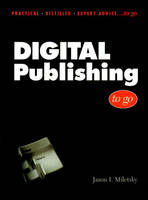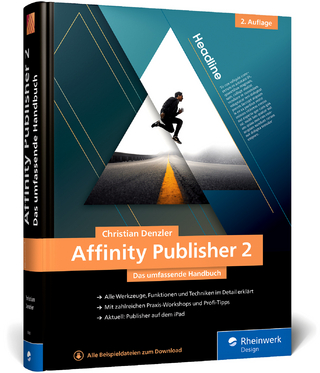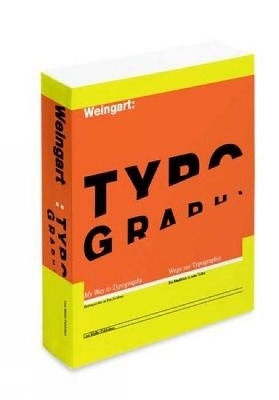
Digital Publishing To Go
Prentice Hall (Verlag)
978-0-13-013536-0 (ISBN)
- Titel ist leider vergriffen;
keine Neuauflage - Artikel merken
PLEASE PROVIDE
Experienced desktop publishers are looking for a single source for productivity and design solutions -- covering all the programs they depend upon. Digital Publishing To Go is a fast-paced, easy-access guide that distills the most critical information experienced desktop publishers need to achieve better results and higher productivity. This book is replete with techniques for both QuarkXPress and PageMaker, on both Mac and PC. It presents great tips for integrating graphics and document files from the leading image and drawing software (including Photoshop, CorelDraw! and Illustrator); and word processing software (such as Microsoft Word). In addition to valuable software coverage, the book contains practical tips and guidance on the business end of desktop publishing -- proven ways to earn higher profits from your creativity and talent. For experienced desktop publishers who want to improve their productivity, create more exciting publications, and make their DTP businesses more profitable.
Jason Miletsky is Partner and Head of Advertising/Design at P/FS New Media in Wayne, NJ. He is author of Photoshop to Go (Prentice Hall PTR).
1. Preparation and General Concepts You Should Know.
A Quick Review of the Process. Understanding Postscript. A Font Is Worth a Thousand Words. Adobe Type Manager. It's Not Easy Being Green (in a Cmyk World). Color in Nature. Colors on Screen: The RGB Color Model. Color in Print: The CMYK Color Model. The World in Black and White: Understanding Grayscale. Manufactured Color: Spot and Specific Colors. Problems and Other Things to Keep in Mind. Other Color Models. Trouble with Trapping. A Heartfelt Plea. When an Image Needs Trapping, and When it Doesn't. Trap Terminology, Issues, and Solutions. Spreading and Choking. Overlapping CMYK. Overprinting. Overprinting Black. Arming Yourself for the Prepress Battle. Buying a Computer: Macintosh or PC? One Simple Rule: Get More RAM! How Much RAM Do You Need? Your Hard Drive: The Other Memory. Getting the Right Monitor. As Many Colors as Possible. Quicker Images and an Extra Bonus. Adding the Peripherals: SCSI and the SCSI Chain. Back-Up and File Transfer Devices. Desktop Scanners. Don't Forget the Printer! What NOT to Do with Your Printer. The Real Reason to Fear Mice. Software You Should Have. Last Thoughts on This Topic. Organizing Your Files. Off the Computer. On the Computer.
2. Getting the Project Started.
The Work Environment. The Initial Meeting. Being Realistic. Ask Yourself the Right Questions. Knowing the Right People. Don't Underestimate the Power of Beer. Pricing. Writing and Signing the Contract. Specifications of Your Project: Preproduction. The Audience. Market Research. Analyzing Market Research. Type of Design. Brochures. Newsletters. Flyers. Catalogs. Oversized Work. Annual Reports. Advertisements. Paper Style. Other Styles. Consistency. The Initial Concept.
3. Quarkxpress and Print Layout.
Quark-Abilities. Version 4.0 Upgrades. A Few Useful Technical Issues in Quarkxpress. Beginning a New Document. Saving QuarkXPress Files. Placing Images. Adding Text. General Layout Issues. Understanding the Difference Between Reader's Spreads and Printer's Spreads. Perfect Binding. Saddle Stitch. Tri-Fold Measurements. “Live Space” in a Magazine Ad.
4. Layout Techniques for Effective Print Design.
General Concepts and QuarkXPress. General Layout Issues. What Your Reader Sees. Making the Message Prominent. Headlines. The Importance of Size and Proportion. Working in XPress: Font Sizes. Length. Headline as Graphic. Imagery. File Formats. Image Size. The Shape of the Image. Working in XPress: Removing the Rectangles. Direction of Your Image. Working in XPress: Flipping Images. More than Words Can Say: The Font Factor. Working in XPress: Font. Beer Before Liquor, Never Sicker—The Trouble with Mixing Fonts. Using Logos. Organizing the Message. Using Subheads. Sizing and Spacing Subheads Effectively. Placement on the Page. Balancing the Page. Utilizing Columns. Working in XPress: Creating Columns. Faster than a Speeding Bullet. The Importance of White Space. Working in XPress: Margins and Space. Avoiding Problems Caused by White Space. Working in XPress: Guides and Rulers. Keeping Consistent. Consistency within a Printed Piece. Image Type Consistency. Font Consistency. Working in XPress: Style Sheets. Two-Page Spreads. Working in XPress: Adding Pages. Consistency Throughout Other Media. Beyond Consistency: Interactivity through Multiple Media. Standard Issues. Using Vertical and Horizontal Rules. Types of Rules. Proper Rule Sizes (Thickness). Proper Rule Sizes (Length). Working in XPress: Working with Rules. Don't Go Crazy with Rules. Working with Boxes. Box Borders. Working in XPress: Creating Box Borders. Box Margins. Working in XPress: Setting Box Margins. Box Shapes. Working in XPress: Creating Box Shapes. Using Color in Your Boxes. Working in XPress: Putting Color in a Box. Justifying Text. Working in XPress: Justifying Text. Body Copy. Kerning. Working in XPress: Kerning. Leading. Working In XPress: Leading. Hyphenations. Working in XPress: Hyphenations. Drop Caps. Working in XPress: Drop Caps. Underlines, Bold, and Italics. Working in XPress: Adding Style to Fonts. Drop Shadows.
5. Working with Adobe Photoshop.
What Can Photoshop Do? What's New in Version 5.0. Specs and Requirements for Photoshop Files. Resolution. Setting Up Photoshop: Color Management and Print Specs. Calibrating Your Monitor. Establishing Color Space. Setting Up RGB Color Gamut. Setting Up CMYK Color Space. Channels: The Heart of Photoshop's Color. The Bare Bones of Channels. Halftone Screens: What They Are and How to Change Them. Getting an Image into Photoshop. Saving an Image: Which File Types to Use. The Photoshop Format. The EPS Format. The TIFF Format.
6. Adding “POP” to Print with Photography.
Where to Get Photographs. Custom Photography. Photo CDs. Your Own Pictures. Stock Photography. Conceptual Issues: What Looks Good and How to Achieve It. Subject Matter. Photo Retouching. Dust, Scratches, and Tears. Problems with Dot Patterns. Keeping Photographs in Focus. Excess Image and Dramatic Effect. Size Effects. Photo Editing. Shadows and Highlights. Brightness. The Power of Color. Four-Color Design Using: CMYK. Changing Colors. Clashing Colors. Two- and Three-Color Printing: Spot Colors, Duotones, and Tritones. Spot Colors. Duotones and Tritones. One Color Printing: Grayscale Images. Enhancing Grayscale Images. Picture Effects. Fading Pictures. Soft Edges. Adding Drop Shadows, Bevels, and Embosses. Torn and Burnt Paper. Flipping Images. Sample Effect: Turning New into Old.
7. Creating Illustrations and Line Art.
Tool of Choice: Adobe Illustrator. Same Chef, Different Meal: Illustrator and Photoshop. Illustrator 8.0: New Additions. Adjusting Color for Print. Changing from RGB to CMYK (and Grayscale, Too!) Mixing a Color: The Color Palette. Creating and Using Colors in Illustrator. Working with the Swatches Palette. Designating a Premixed Color. Adding Color to Your Image. Overprinting Spot Colors. File Formats for Saving Images. Native Illustrator. Illustrator EPS. The Heart of Illustrator: Creating Paths. Pierre Bzier: As Twisted as They Come. Creating with the Pen Tool. Creating a Straight Line Path. Ending a Path. Creating Curved Paths. Filling and Stroking Your Path. More (and More General) Path Info. Joining Paths. Compound Paths. Cutting a Path. And That's It for Paths! Setting Traps. Setting Traps by Overprinting Black. Conceptual Issues: What Works in Illustration. Lightening the Mood with Cartoon Illustrations. Realistic Illustrations. Abstract Illustrations. Technical Drawings and Diagrams. Some Type of Fun. Type Along a Path. Turning Text into a Path. Printing from Illustrator.
8. Preparing Files for Print: Working with a Service Bureau.
A Brief Overview of Printing and the Service Bureau's Place in Our World. Things You Should Know When Choosing a Service Bureau. How Do You Find a Service Bureau, and Do You Need More Than One? Does Platform Matter? Getting Files Ready for Output: A Tale of Two Choices. Providing Raw Files. The Quark Files. Fonts. Checklist for Presenting Raw Files. Review All Files: Did You Check… Collect All Files: Did You Provide… Fonts: Did You Provide… Sample Printouts: Did You… What If I Forget an Element of My Project? Providing the Postscript Files. Checking Your Document Before You Set Up Your PostScript File. Postscript Files From Either Macintosh or Windows. QuarkXPress Print Dialog Box. Print Styles. Copies. Pages and Range Separators. Document Tab. Separations. Include Blank Pages. Page Sequence. Registration. Tiling. Overlap. Spreads. Thumbnails. Bleed. Offset. Collate. Back to Front. Quick Checklist of Document Tab:. Setup Tab. Printer Description. Paper Size and its Underlings. Reduce or Enlarge. Page Positioning. Fit in Print Area. Orientation. Quick Checklist of Setup Tab. Output Tab. Print Colors/Plates. Halftoning. Resolution. Frequency. That Big, Crazy Box at the Bottom. Halftone. Frequency. Angle. Function. Quick Checklist of Output Tab. Ootions Tab. PostScript Handling Error. Page Flip. Negative Print. Picture Output. Quick Checklist of Options Tab. The Preview Tab. Paper Size. Document Size. Paper Margins. Print Info. Preview Graphic. To Create a PostScript File from a Macintosh. To Begin Printing and PostScript Prep from a Windows Machine. Don't Forget the Matchprint. Making the Handoff. Getting the Film Back.
9. Printing—Finally, the Last Step.
Matching Your Project to the Right Printer. Desktop Printers. Laser Printers. Ink Jet Printers. Digital Presses. What's So Good About Digital Printing. What's Not So Good About Digital Printing. Checklist for Using a Digital Press. Large Format Printing. Commercial Printing (Lithography). What to Look for (and Not to Look for) in a Commercial Printer.
Index.
| Erscheint lt. Verlag | 1.1.2000 |
|---|---|
| Verlagsort | Upper Saddle River |
| Sprache | englisch |
| Maße | 178 x 235 mm |
| Gewicht | 600 g |
| Themenwelt | Informatik ► Grafik / Design ► Desktop Publishing / Typographie |
| ISBN-10 | 0-13-013536-4 / 0130135364 |
| ISBN-13 | 978-0-13-013536-0 / 9780130135360 |
| Zustand | Neuware |
| Informationen gemäß Produktsicherheitsverordnung (GPSR) | |
| Haben Sie eine Frage zum Produkt? |
aus dem Bereich


